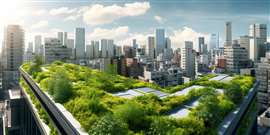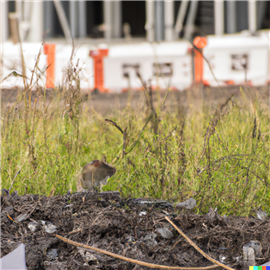Biodiversity: An engineer’s role in repairing the planet
29 June 2023
Biodiversity is essential for all life on earth, not a nice-to-have that we can afford to do without.
 Image: Adobe Stock
Image: Adobe Stock
Nevertheless, environmental improvement has too often been seen as an extra, rather than a vital component of good infrastructure design.
Marginal biodiversity losses have been accepted as par for the course.
The slow demise of biodiversity
Every time any development is planned – be it a railway, a road, a car park, a bridge, an airport, or an apartment block – an environmental impact assessment generally highlights the risk of biodiversity loss.
While mitigation measures are put in place, it’s assumed that any small loss won’t make a difference in the grand scheme of things.
Yet, cumulatively, its these marginal, incremental biodiversity losses in farming, construction and development that have helped to create this creeping epidemic of biodiversity loss.
Taking the UK as an example, the onus until this year has been for companies to meet biodiversity targets was largely voluntary, so typically projects aimed to replace what was lost, rather than enhance the environment.
 Image: DALL.E
Image: DALL.E
However, according to a House of Commons Environmental Audit Committee, in less than a lifetime, there has been a 68% decrease in the UK population sizes of mammals, birds, amphibians, reptiles, and fish.
Now, more than one in seven of the UK’s native species face extinction, and more than 40% are in decline.
Heeding the call for legislation
Given this increasingly worrying outlook for UK biodiversity, from November 2023, the government will introduce a biodiversity net gain (BNG) target of 10%.
In short, BNG will require land managers, developers, and local authorities to approach development in a way that leaves “habitats for wildlife in a measurably better state than they were in before the development”.
This target will fundamentally change the way that habitat losses are considered as part of development.
Rather than seek to mitigate the negative impact of construction on biodiversity, engineers and developers will instead be required to ‘design in’ ways to protect, conserve, improve or extend biodiversity.
And the measures will need to be maintained for 30 years.
It’s a decision that will affect hundreds of companies that manage tens of thousands of hectares of land.
However, it should not come as a surprise to most. It has become increasingly common for infrastructure projects to be sent back to the drawing board based on climate or environmental grounds.
Project owners and contractors alike are quickly beginning to understand their role in tackling the biodiversity crisis.
Incorporating biodiversity into design
What we must do now – not just in the UK, but throughout Europe – is formalise how to incorporate biodiversity into the original design and move away from addressing it solely through mitigation.
Clever biological engineering needs to become a big part of how we build. To do so will require a minimum level of knowledge of wildlife and biology among designers and engineers, access to expertise, and appropriate regulation and monitoring to ensure that the reality delivers on the vision.
Some biodiversity design decisions are simple – replacing post and wire fencing with laid hedging, or specifying a diverse range of native tree species, rather than creating a monoculture forest.
The choice of materials and finishes can also have a positive impact on biodiversity.
Specifying a bridge’s concrete piers to have a rough, more biologically active surface may create a habitat for seaweed and crustaceans, for example.
 Alistair Kean, sustainability director with the engineering and architecture consultancy COWI. Photo: COWI
Alistair Kean, sustainability director with the engineering and architecture consultancy COWI. Photo: COWI
Similarly, creatures need puddles to submerge in, or drink from and rocks to sun themselves on, so creating embankments and cuttings with a rough, natural texture is preferable to the super smooth finish we see on many projects today.
Positive blueprint in Germany
The part-EU-funded Project INADAR is a good example of how the use of natural materials over concrete has allowed biodiversity to flourish on the dams and associated waterways at two of Germany’s hydropower plants.
As a result, the number of plant species along the riverbanks has more than doubled, and there have been similarly positive impacts on fish and birds.
The approach was also a third cheaper than conventional concrete based methods.
Other design decisions are more holistic in scale.
Regenerated mudflats operate as natural coastal erosion protection, wetlands can treat contaminated water, and upland rivers can be re-meandered to both restore natural habitats and reduce flooding downstream.
In many cases, by better managing the landscape, and choosing biologically appropriate designs, we can avoid or significantly reduce the need for hard engineering – which reduces our current need for highly carbon-emitting concrete and steel.
Even renaturalising short sections of degraded rivers can reduce flooding by more than 20 per cent.
New choices, new skills
A lot of the change required to encourage biodiversity is mirrored by the design journey being undertaken to address carbon emissions.
In just a few years, a significant upskilling has taken place that now sees designers and engineers confident in their understanding of how design decisions impact embodied carbon.
Tackling the biodiversity crisis needs the same enthusiasm and resourcing.
Some aspects of biodiversity are incredibly complex and highly interdependent – just look at a typical food web – small impacts can have vast consequences.
Similarly, tools that measure and monitor biodiversity are relatively complex and the huge variety of possible interventions across grassland, woodland, and the water environment will understandably have varying impacts on biodiversity.
In the UK, to meet or exceed the 10% minimum while also continuing to meet cost, schedule and safety objectives will require a base level of biological understanding, as well as access to specialist knowledge.
As with other aspects of design, engineers will need to understand how their choices will unfold over the lifetime of the project.
In some cases, it may be more cost-effective or practical to partly achieve biodiversity net gains by creating habitat enhancements offsite.
For some developers, purchasing marginal pockets of land to enhance will be more cost effective or physically achievable than achieving all net biodiversity gains onsite.
Everyone has a role to play
In impact terms, the 10% biodiversity net gain proposition is just the start of environmental repair.
Biodiversity decline is already having a marked impact, and it must be reversed swiftly if we are to avoid a full scale environmental and social catastrophe.
Just imagine a world without pollinators. Bees pollinate 70 of the around 100 crop species that feed 90% of the world. Without them, yields would fall massively.
Landowners, developers, construction engineers, contractors, and the supply chain at large all have a role to play in incorporating biodiversity into design.
Every construction project is an opportunity to right some of the wrongs of the past and together, cumulatively, their combined biodiversity net gains should help to reverse the decline.
| About the Author Alistair Kean is the sustainability director with the UK division of COWI, an international consulting group specialising in engineering, environmental science and economics, with headquarters in Lyngby, Denmark. |
STAY CONNECTED



Receive the information you need when you need it through our world-leading magazines, newsletters and daily briefings.
CONNECT WITH THE TEAM







